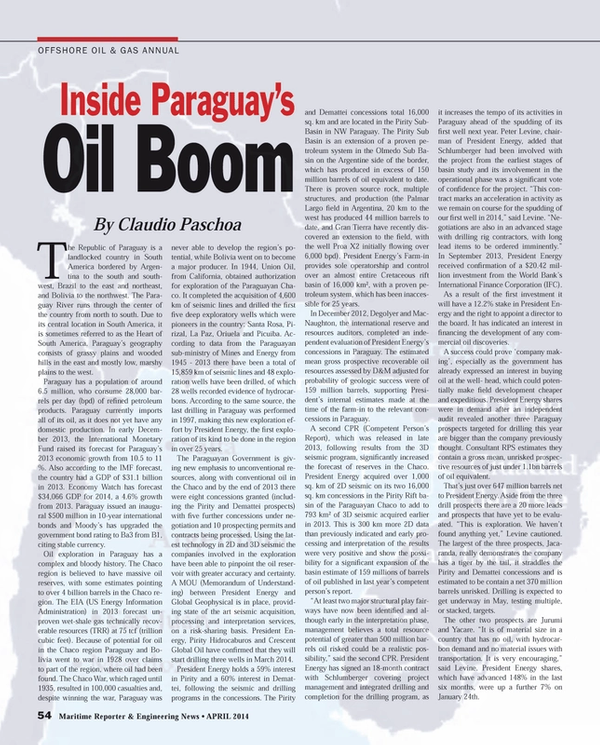
Inside Paraguay’s Oil Boom
The Republic of Paraguay is a landlocked country in South America bordered by Argentina to the south and southwest, Brazil to the east and northeast, and Bolivia to the northwest. The Paraguay River runs through the center of the country from north to south. Due to its central location in South America, it is sometimes referred to as the Heart of South America. Paraguay’s geography consists of grassy plains and wooded hills in the east and mostly low, marshy plains to the west.
Paraguay has a population of around 6.5 million, who consume 28,000 barrels per day (bpd) of refined petroleum products. Paraguay currently imports all of its oil, as it does not yet have any domestic production. In early December 2013, the International Monetary Fund raised its forecast for Paraguay’s 2013 economic growth from 10.5 to 11 %. Also according to the IMF forecast, the country had a GDP of $31.1 billion in 2013. Economy Watch has forecast $34,066 GDP for 2014, a 4.6% growth from 2013. Paraguay issued an inaugural $500 million in 10-year international bonds and Moody’s has upgraded the government bond rating to Ba3 from B1, citing stable currency.
Oil exploration in Paraguay has a complex and bloody history. The Chaco region is believed to have massive oil reserves, with some estimates pointing to over 4 billion barrels in the Chaco region. The EIA (US Energy Information Administration) in 2013 forecast unproven wet-shale gas technically recoverable resources (TRR) at 75 tcf (trillion cubic feet). Because of potential for oil in the Chaco region Paraguay and Bolivia went to war in 1928 over claims to part of the region, where oil had been found. The Chaco War, which raged until 1935, resulted in 100,000 casualties and, despite winning the war, Paraguay was never able to develop the region’s potential, while Bolivia went on to become a major producer. In 1944, Union Oil, from California, obtained authorization for exploration of the Paraguayan Chaco. It completed the acquisition of 4,600 km of seismic lines and drilled the first five deep exploratory wells which were pioneers in the country: Santa Rosa, Pirizal, La Paz, Oriuela and Picuiba. According to data from the Paraguayan sub-ministry of Mines and Energy from 1945 - 2013 there have been a total of 15,859 km of seismic lines and 48 exploration wells have been drilled, of which 28 wells recorded evidence of hydrocarbons. According to the same source, the last drilling in Paraguay was performed in 1997, making this new exploration effort by President Energy, the first exploration of its kind to be done in the region in over 25 years.
The Paraguayan Government is giving new emphasis to unconventional resources, along with conventional oil in the Chaco and by the end of 2013 there were eight concessions granted (including the Pirity and Demattei prospects) with five further concessions under negotiation and 10 prospecting permits and contracts being processed. Using the latest technology in 2D and 3D seismic the companies involved in the exploration have been able to pinpoint the oil reservoir with greater accuracy and certainty. A MOU (Memorandum of Understanding) between President Energy and Global Geophysical is in place, providing state of the art seismic acquisition, processing and interpretation services, on a risk-sharing basis. President Energy, Pirity Hidrocaburos and Crescent Global Oil have confirmed that they will start drilling three wells in March 2014.
President Energy holds a 59% interest in Pirity and a 60% interest in Demattei, following the seismic and drilling programs in the concessions. The Pirity and Demattei concessions total 16,000 sq. km and are located in the Pirity Sub-Basin in NW Paraguay. The Pirity Sub Basin is an extension of a proven petroleum system in the Olmedo Sub Basin on the Argentine side of the border, which has produced in excess of 150 million barrels of oil equivalent to date. There is proven source rock, multiple structures, and production (the Palmar Largo field in Argentina, 20 km to the west has produced 44 million barrels to date, and Gran Tierra have recently discovered an extension to the field, with the well Proa X2 initially flowing over 6,000 bpd). President Energy’s Farm-in provides sole operatorship and control over an almost entire Cretaceous rift basin of 16,000 km², with a proven petroleum system, which has been inaccessible for 25 years.
In December 2012, Degolyer and MacNaughton, the international reserve and resources auditors, completed an independent evaluation of President Energy’s concessions in Paraguay. The estimated mean gross prospective recoverable oil resources assessed by D&M adjusted for probability of geologic success were of 159 million barrels, supporting President’s internal estimates made at the time of the farm-in to the relevant concessions in Paraguay.
A second CPR (Competent Person’s Report), which was released in late 2013, following results from the 3D seismic program, significantly increased the forecast of reserves in the Chaco. President Energy acquired over 1,000 sq. km of 2D seismic on its two 16,000 sq. km concessions in the Pirity Rift basin of the Paraguayan Chaco to add to 793 km² of 3D seismic acquired earlier in 2013. This is 300 km more 2D data than previously indicated and early processing and interpretation of the results were very positive and show the possibility for a significant expansion of the basin estimate of 159 millions of barrels of oil published in last year’s competent person’s report.
“At least two major structural play fairways have now been identified and although early in the interpretation phase, management believes a total resource potential of greater than 500 million barrels oil risked could be a realistic possibility,” said the second CPR. President Energy has signed an 18-month contract with Schlumberger covering project management and integrated drilling and completion for the drilling program, as it increases the tempo of its activities in Paraguay ahead of the spudding of its first well next year. Peter Levine, chairman of President Energy, added that Schlumberger had been involved with the project from the earliest stages of basin study and its involvement in the operational phase was a significant vote of confidence for the project. “This contract marks an acceleration in activity as we remain on course for the spudding of our first well in 2014,” said Levine. “Negotiations are also in an advanced stage with drilling rig contractors, with long lead items to be ordered imminently.” In September 2013, President Energy received confirmation of a $20.42 million investment from the World Bank’s International Finance Corporation (IFC).
As a result of the first investment it will have a 12.2% stake in President Energy and the right to appoint a director to the board. It has indicated an interest in financing the development of any commercial oil discoveries.
A success could prove ‘company making’, especially as the government has already expressed an interest in buying oil at the well- head, which could potentially make field development cheaper and expeditious. President Energy shares were in demand after an independent audit revealed another three Paraguay prospects targeted for drilling this year are bigger than the company previously thought. Consultant RPS estimates they contain a gross mean, unrisked prospective resources of just under 1.1bn barrels of oil equivalent.
That’s just over 647 million barrels net to President Energy. Aside from the three drill prospects there are a 20 more leads and prospects that have yet to be evaluated. “This is exploration. We haven’t found anything yet,” Levine cautioned. The largest of the three prospects, Jacaranda, really demonstrates the company has a tiger by the tail, it straddles the Pirity and Demattei concessions and is estimated to be contain a net 370 million barrels unrisked. Drilling is expected to get underway in May, testing multiple, or stacked, targets.
The other two prospects are Jurumi and Yacare. “It is of material size in a country that has no oil, with hydrocarbon demand and no material issues with transportation. It is very encouraging,” said Levine. President Energy shares, which have advanced 148% in the last six months, were up a further 7% on January 24th.
(As published in the April 2014 edition of Maritime Reporter & Engineering News - http://magazines.marinelink.com/Magazines/MaritimeReporter)
Read Inside Paraguay’s Oil Boom in Pdf, Flash or Html5 edition of April 2014 Maritime Reporter
Other stories from April 2014 issue
Content
- Offshore: Seacor Raises the Bar Again page: 13
- Offshore Service Vessels Design Innovation page: 14
- U.S. Coast Guard Doing Less with Less page: 18
- New Conept Under Test: Arctic Drillship page: 20
- If You Have DPS Questions ... OSVDPA Has Answers page: 22
- How to Work with Your Insurer When Experiencing a Loss page: 24
- Calculating Settlement Value of a Case page: 26
- Strategic Planning With Aggregate Data page: 30
- Is Internal Combustion Engine Methane Slip Harmful to the Environment? page: 32
- Floating Production Growth May Face Obstacles page: 38
- Arctic Energy Exploration Efforts Heat Up page: 44
- Saipem: A Fleet Grows in Brazil page: 50
- Inside Paraguay’s Oil Boom page: 54
- The History of Offshore Energy page: 56
- Offshore Energy Timeline:1806-2014 page: 56
- C-MAR's Modern Approach to DP Training in Brazil page: 64
- CNR: Innovation Maintains US Naval Advantages page: 66
- STEM: SeaPerch Underwater Robotic Championships page: 72
- Safety the Focus as Heavy Lifting Picks Up page: 78
- Cool Runnings: R.W. Fernstrum's Engineered Solutions page: 82
- Rosie the Riveter: WWII Women Shipyard Workers Visit the White House page: 88
- Modern Solutions Power Systems Conference page: 91
- ABS Approves Design for GTTNA’s LNG Bunker Barge page: 92
- Rolls-Royce Wins Heyerdahl Award page: 94
- Damen Opens JV Yard in Vietnam page: 95
- BASS Launches New Fleet Management System page: 96
- Shipboard Pipe-joining Techniques Examined page: 98
- Luxury Yachts: Design Takes a New Track page: 100
- New Air Regulator from TDI page: 103
- DNV GL ShipManager for Entire H&P Fleet page: 103
- FARO Debuts X Series Laser Scanner page: 103
- Jinglu Chooses AVEVA Design Software page: 103
- Macro Sensors Gauge Tank Volume Changes page: 103
- Special Coupling Solution for Offshore Drives page: 103
- Conquest Offshore Buys Star Software page: 103
- Eniram Launches New Optimization Product for LNG Sector page: 104
- COSCO Selects Rolls-Royce Package page: 104
- New Tests for Ballast Water Contamination page: 104
- SSI Debuts Updated ShipConstructor page: 104
- Wärtsilä’s Launches Inline Scrubber System page: 104
- New Transas Liquid Cargo Handling Simulator page: 104
- New Hull Structure Analysis Software page: 104
- GEA Westfalia Separator Launches New Control Generation page: 105
- Omega Debuts Compact RTD Temperature Sensors page: 105
- New Heavy Duty CNC Plasma System page: 105
- Wärtsilä Introduces 46DF Dual Fuel Engine page: 105
- WSS Achieves Better Onboard Air Quality page: 105
- Trojan Marinex BWT System Earns IMO Type Approval page: 106


